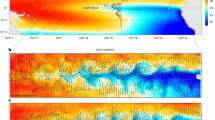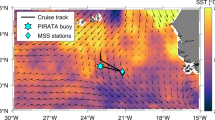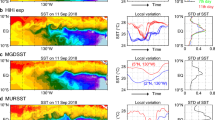Abstract
Changes in sea surface temperature of equatorial waters have critical effects on the large-scale atmospheric circulation1,2,3. So far, large-scale, energetic tropical instability waves in equatorial waters have been thought to warm the sea surface through both meridional and zonal advection4,5. Here, we present shipboard profiling measurements of turbulence kinetic-energy dissipation rate that reveal unanticipated vigorous mixing associated with tropical instability waves. The meridional tropical instability-wave shear increases the shear above the core of the Equatorial Undercurrent, which is already large, nudging the flow toward instability. As a consequence, turbulence dissipation rates and heat fluxes are many times greater than previous measurements at the same location but in the absence of tropical instability waves. The vertical divergence of turbulence heat flux is sufficient to cool the upper layer by 2 K per month, and heat the core of the Equatorial Undercurrent by 10 K per month. Long-term records at 140∘ W further reveal that cooling of the sea surface is significantly correlated to tropical-instability-wave kinetic energy. Thus, seasonal surface cooling in the central equatorial Pacific may be largely caused by mixing induced by tropical instability waves.
This is a preview of subscription content, access via your institution
Access options
Subscribe to this journal
Receive 12 print issues and online access
$259.00 per year
only $21.58 per issue
Buy this article
- Purchase on Springer Link
- Instant access to full article PDF
Prices may be subject to local taxes which are calculated during checkout




Similar content being viewed by others
References
Maloney, E. D. & Kiehl, J. T. MJO-related SST variations over the tropical eastern Pacific during Northern Hemisphere summer. J. Clim. 15, 675–689 (2002).
Hashizume, H. et al. Direct observations of atmospheric boundary layer response to SST variations associated with tropical instability waves over the eastern equatorial Pacific. J. Clim. 15, 3379–3391 (2002).
McPhaden, M. J., Zebiak, S. E. & Glanz, M. H. ENSO as an integrating concept in earth science. Science 314, 1740–1745 (2006).
Wang, W. & McPhaden, M. J. The surface layer heat balance in the equatorial Pacific ocean. Part I: Mean seasonal cycle. J. Phys. Oceanogr. 29, 1812–1831 (1999).
Jochum, M., Cronin, M. F., Kessler, W. S. & Shea, D. Observed horizontal temperature advection by tropical instability waves. Geophys. Res. Lett. 34, L09604 (2007).
Moum, J. N., Caldwell, D. R. & Paulson, C. A. Mixing in the equatorial surface layer and thermocline. J. Geophys. Res. 94, 2005–2021 (1989).
Peters, H., Gregg, M. C. & Toole, J. M. On the parameterization of equatorial turbulence. J. Geophys. Res. 93, 1199–1218 (1988).
Moum, J. N. & Caldwell, D. R. Local influences on shear flow turbulence in the equatorial ocean. Science 230, 315–316 (1985).
Gregg, M. C., Peters, H., Wesson, J. C., Oakey, N. S. & Shay, T. J. Intensive measurements of turbulence and shear in the Equatorial Undercurrent. Nature 318, 140–144 (1985).
Hebert, D., Moum, J. N., Paulson, C. P. & Caldwell, D. R. Turbulence and internal waves at the equator. Part II: Details of a single event. J. Phys. Oceanogr. 22, 1346–1356 (1992).
Lien, R.-C., Caldwell, D. R., Gregg, M. C. & Moum, J. N. Turbulence variability at the Equator in the Central Pacific at the beginning of the 1991–93 El Niño. J. Geophys. Res. 100, 6881–6898 (1995).
Zaron, E. D. & Moum, J. N. A new look at Richardson number mixing schemes for equatorial ocean modeling. J. Phys. Oceanogr. 39, 2652–2664 (2009).
McPhaden, M. J. Genesis and evolution of the 1997–98 El Niño. Science 283, 950–954 (1999).
Menkes, C. E., Vialard, J., Kennan, S. C., Boulanger, J. & Madec, G. V. A modeling study of the impact of tropical instability waves on the heat budget of the eastern equatorial Pacific. J. Phys. Oceanogr. 36, 847–865 (2006).
Lien, R.-C., D’Asaro, E. A. & Menkes, C. E. Modulation of equatorial turbulence by tropical instability waves. Geophys. Res. Lett. 35, L24607 (2008).
Legeckis, R. Long waves in the eastern equatorial Pacific Ocean: A view from a geostationary satellite. Science 197, 1179–1181 (1977).
Miller, L., Watts, D. R. & Wimbush, M. Oscillations of dynamic topography in the eastern equatorial Pacific. J. Phys. Oceanogr. 15, 1759–1770 (1985).
Strutton, P. G., Ryan, J. P. & Chavez, F. P. Enhanced chlorophyll associated with tropical instability waves in the equatorial Pacific. Geophys. Res. Lett. 28, 2005–2008 (2001).
McPhaden, M. J. Monthly period oscillations in the Pacific North equatorial countercurrent. J. Geophys. Res. 101, 6337–6359 (1996).
Halpern, D., Knox, R. A. & Luther, D. S. Observations of 20-day period meridional current oscillations in the upper ocean along the Pacific Equator. J. Phys. Oceanogr. 18, 1514–1534 (1988).
Lyman, J. M., Johnson, G. C. & Kessler, W. S. Structure of 17-day versus 33-day tropical instability waves in the equatorial Pacific. J. Phys. Oceanogr. 37, 855–872 (2007).
Moum, J. N., Hebert, D., Paulson, C. A. & Caldwell, D. R. Turbulence and internal waves at the Equator. Part I: Statistics from towed thermistors and a microstructure profiler. J. Phys. Oceanogr. 22, 1330–1345 (1992).
Drazin, P. G. & Reid, W. H. Hydrodynamic Stability (Cambridge Univ. Press, 1981).
Osborn, T. R. Estimates of the local rate of turbulent diffusion from dissipation measurements. J. Phys. Oceanogr. 10, 83–89 (1980).
Fairall, C. W., Bradley, E. F., Rogers, D. P., Edson, J. B. & Young, G. S. Bulk parameterization of air–sea fluxes in TOGA COARE. J. Geophys. Res. 101, 3747–3767 (1996).
McPhaden, M. J. TOGA-TAO and the 1991–93 El Niño-Southern Oscillation event. Oceanography 6, 36–44 (1993).
Masina, S., Philander, S. G. H. & Bush, A. B. G. An analysis of tropical instability waves in a numerical model of the Pacific Ocean 2. Generation and energetics of the waves. J. Geophys. Res. 104, 29637–29661 (1999).
Moum, J. N., Gregg, M. C., Lien, R.-C. & Carr, M. E. Comparison of turbulent kinetic energy dissipation rates from two ocean microstructure profilers. J. Atmos. Ocean. Technol. 12, 346–366 (1995).
Acknowledgements
This research was funded by the National Science Foundation (0424133, 0728375). Thanks to M. Neeley-Brown, R. Kreth, K. Chabuk, J. Johnson, A. Schmittner, M.-H. Chang and J. Milliard for their assistance in obtaining these measurements, to the captain and crew of the R/V Wecoma for provision of an experimental platform and to NOAA’s TAO Project office for the equatorial mooring data. A. Schmittner, E. Shroyer, D. Chelton, M. McPhaden and B. Smyth provided comments.
Author information
Authors and Affiliations
Contributions
All authors contributed extensively to the work presented in this paper.
Corresponding author
Supplementary information
Supplementary Information
Supplementary Information (PDF 757 kb)
Rights and permissions
About this article
Cite this article
Moum, J., Lien, RC., Perlin, A. et al. Sea surface cooling at the Equator by subsurface mixing in tropical instability waves. Nature Geosci 2, 761–765 (2009). https://doi.org/10.1038/ngeo657
Received:
Accepted:
Published:
Issue Date:
DOI: https://doi.org/10.1038/ngeo657
This article is cited by
-
Intensification of Pacific tropical instability waves over the recent three decades
Nature Climate Change (2024)
-
Persistent mixing bursts in the equatorial Pacific thermocline induced by persistent equatorial waves
Journal of Oceanology and Limnology (2024)
-
El Niño/Southern Oscillation inhibited by submesoscale ocean eddies
Nature Geoscience (2022)
-
The adjoint-based Two Oceans One Sea State Estimate (TOOSSE)
Journal of Oceanology and Limnology (2022)
-
Future high-resolution El Niño/Southern Oscillation dynamics
Nature Climate Change (2021)



